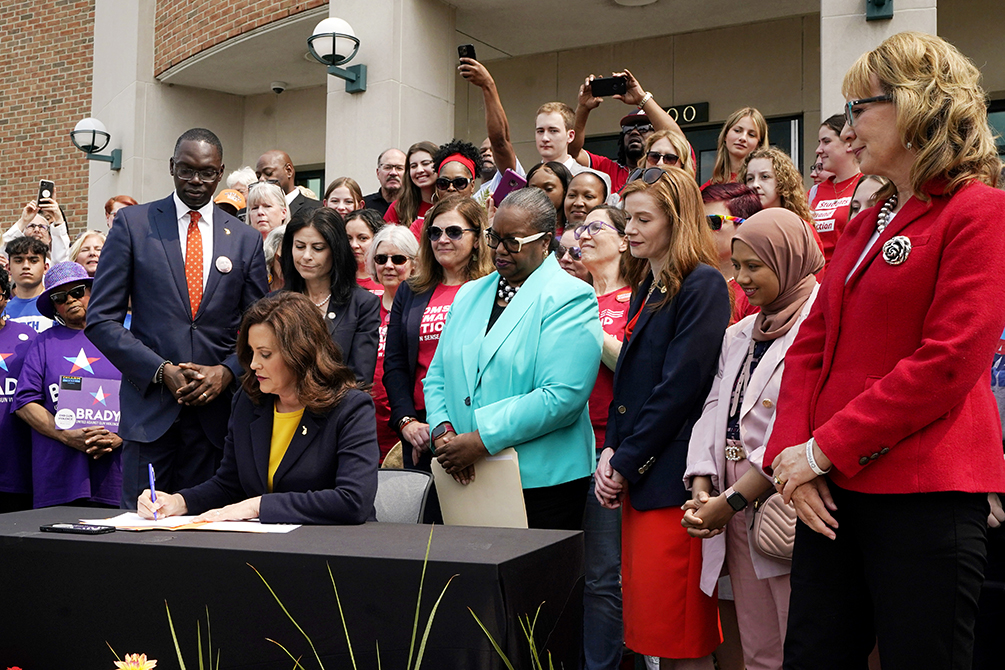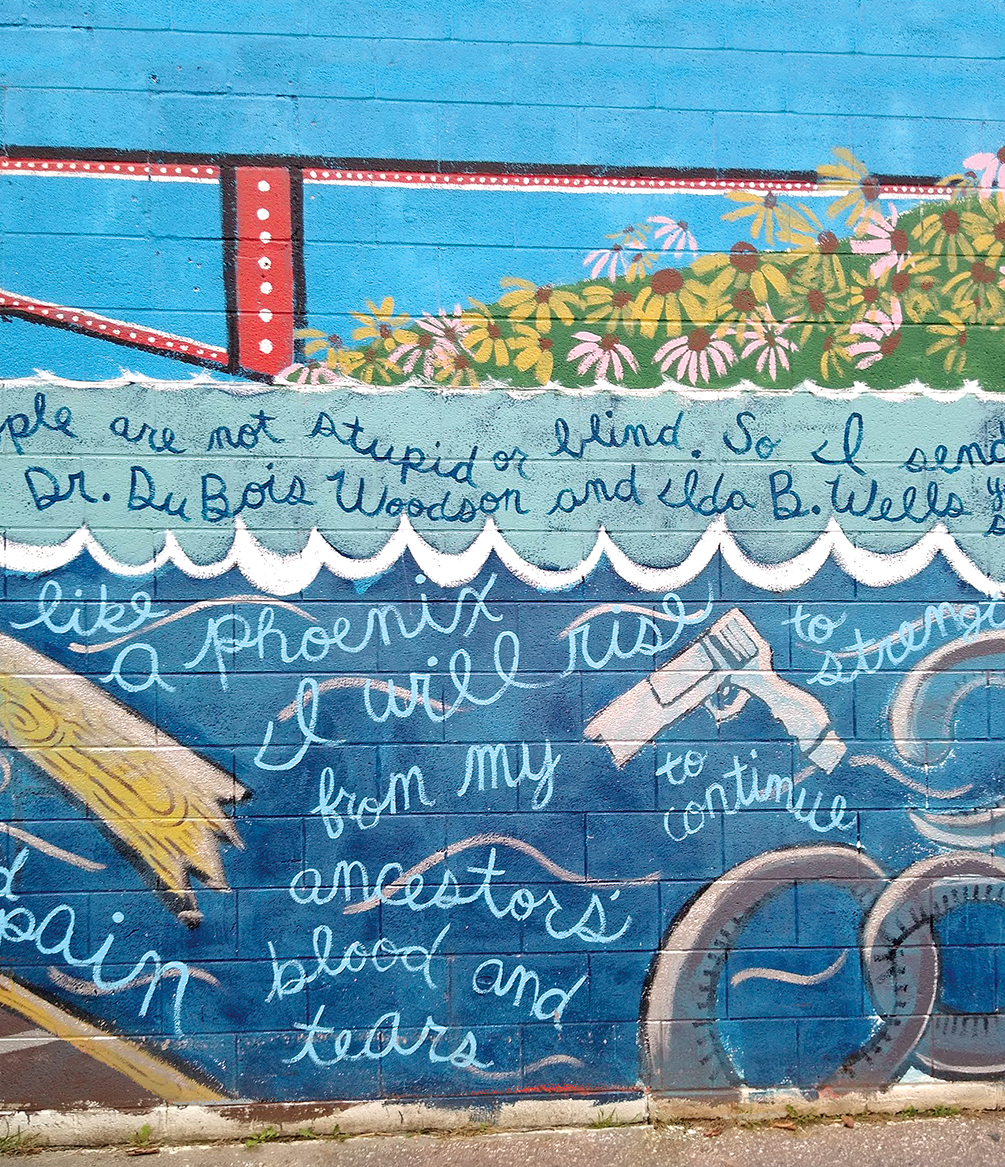Stopping the gun violence epidemic

Michigan Public Health has marshaled its resources to respond to this public health crisis
By Claudia Capos
Last year, April Zeoli, associate professor of Health Management and Policy at the University of Michigan School of Public Health, traveled to Royal Oak, Michigan, to watch a much-anticipated bill-signing event take place on the steps of the district courthouse.
Prominent legislators, law enforcement officers and public safety advocates gathered in the city on May 22, 2023, to witness this historic moment in the state’s campaign against gun violence, which claimed 1,500 lives in Michigan in 2021, according to the US Centers for Disease Control and Prevention.
At the event, Michigan Gov. Gretchen Whitmer signed a landmark package of bills that included the establishment of extreme risk protection orders (ERPOs) in Michigan.
ERPOs, also known as “red flag” laws, authorize family members, police officers and healthcare professionals to seek a court order to temporarily remove the guns of someone who represents a danger to themselves or others and prevent them from purchasing guns. Michigan became the 21st state to adopt this type of legal safeguard.
“It was an important moment that will affect a lot of Michigan families in a positive way,” said Zeoli, who, like many Americans, has lost loved ones to firearms. “This is about saving lives and sparing families and friends the grief of losing someone to gun suicide or homicide.”
In recent years, public concerns about the alarming increase in firearm deaths, injuries and suicides have intensified, as news about mass shootings at schools, universities, churches, synagogues, music festivals and bars has filled social media channels and the airwaves. The CDC reports that 20,958 homicides and 26,328 suicides resulted from firearms in 2021, which is the most recent year that official data are available.
Our role at the school is to do rigorous, high-quality research that informs issues and problems. We bring science to the conversation by sharing our research findings so policymakers can be fully informed and use that information to craft their responses to an issue.”
— April Zeoli
Michigan Public Health has marshaled its resources to respond to this public health crisis. Faculty with diverse research interests are studying the causes of gun violence, exploring various interventions to address the problem, and helping to shape public policies and programs designed to make Michigan schools and communities safer.
“Our role at the school is to do rigorous, high-quality research that informs issues and problems,” said Zeoli, who is also Policy Core director for the University of Michigan Institute for Firearm Injury Prevention. “We bring science to the conversation by sharing our research findings so policymakers can be fully informed and use that information to craft their responses to an issue.”
The bill signing in May 2023 was a milestone for Zeoli, who has studied the enactment, implementation and effectiveness of ERPOs in other states and testified on firearm injury prevention policy before the US House of Representatives Gun Violence Prevention Task Force.
She brought this extensive research knowledge and expertise in policy-making to the table while Michigan legislators were drafting and evaluating the ERPO act.
“I was one of many people who weighed in on early versions of the bill with suggestions on how to improve it, based on my research and knowledge of ERPO laws in other states,” Zeoli said. “These suggestions helped legislators craft a better bill and were largely incorporated in the final version that passed the Michigan House and Senate.”
Michigan’s new ERPO law is one of four key pieces of legislation signed into law last year to reduce suicides and to keep guns out of the hands of domestic abusers, mentally unstable individuals and violent criminals. The other three laws are:
- Firearm storage laws requiring the safe storage of guns in locked containers or secured with a locking device when minors are present on the premises
- Expanded background checks related to all firearm purchases, from handguns to long guns
- A fourth law passed after the prior three will prohibit individuals convicted of misdemeanor domestic violence from accessing firearms for eight years after completion of penalties
RELATED CONTENT:
- Read more: Michigan latest state to enforce new firearm laws meant to lessen injuries, deaths
- Watch on Instagram: Brandon Wolf, survivor of the 2016 shooting at Pulse nightclub in Orlando: 'It breaks my heart that my story is not unique.'
“We have enacted common sense gun violence prevention laws supported by a majority of Michiganders including universal background checks, safe storage requirements, and extreme risk protection orders,” Whitmer said. “We got it done thanks to our state legislators, public safety officials and scholars like Dr. April Zeoli, whose research on ERPO laws will help us save lives. Let’s keep working together so people can go to work, drop their kids off at school and take a walk in their neighborhood safely.”
The new Michigan gun laws, which went into effect Feb. 13, represent an important first step in the battle to reduce firearm deaths and injuries. However, more work needs to be done to stop the epidemic of gun violence.

Vetting new firearm restrictions
ERPO laws are relatively new tools for removing firearms from people who are in danger of harming themselves or other individuals. Before 2014, only two states had these “red flag” laws and not much was known about them.
To learn more, Zeoli conducted the largest ERPO study in the United States, which entailed looking at more than 6,500 cases in six states. Her preliminary findings are quite promising.
“My research suggests that ERPOs are associated with reduced risk of suicide,” Zeoli said. “We don’t have research on homicides yet, but there’s every reason to hypothesize that ERPOs will be effective in reducing the risk of homicide as well.”
Another facet of Zeoli’s research looks at the impact of gun violence prevention laws on intimate partner homicide, where a person is killed by a current or former spouse or partner. In Michigan, a personal protection order (PPO) shields an individual from an abuser and may include a firearm restriction.
My research suggests that ERPOs are associated with reduced risk of suicide. We don’t have research on homicides yet, but there’s every reason to hypothesize that ERPOs will be effective in reducing the risk of homicide as well.”
— April Zeoli
Zeoli currently is collecting data and interviewing victims of intimate partner violence for a three-state study focused on PPOs to examine whether having a firearm restriction increases safety.
A firearm purchaser license law, such as Michigan’s, helps to ensure that abusers who are under personal or domestic violence protective orders will not be able to buy a gun when they apply for a purchase license after a background check is conducted, Zeoli said.
Her next step will be to evaluate Michigan’s new ERPO law to make sure it is working as intended.
“We will conduct research to see if the ERPO law is actually reducing firearm deaths in Michigan and what we can do to make the law more effective,” she said. “Other state legislatures will look to our findings and apply them in their own states.”

Making Michigan public schools safer
When news of the mass shooting at Oxford High School broke on Nov. 30, 2021, Justin Heinze, associate professor of Health Behavior and Health Education, sprang into action.
“The first thing I did when I heard about this shooting was to begin our outreach to area schools in Oakland County,” said Heinze, co-director of the National Center for School Safety, which recently was awarded a $7.9 million, three-year grant by the Bureau of Justice Assistance to provide expert-led training, technical assistance and evidence-based resources that address school safety challenges.
In addition, he is the director of the University of Michigan Institute for Firearm Injury Prevention’s School Safety Section. Heinze also leads Public Health IDEAS for Preventing Firearm Injuries, a Michigan Public Health initiative launched in 2021 that pursues root causes and actionable solutions to minimize firearm injuries and deaths.
I feel strongly that by using data-driven, evidence-based approaches, we will ultimately turn the tide on this disturbing trend in gun violence, just as we did with other concerns in schools, such as bullying.”
— Justin Heinze
“It’s very difficult for schools that are going through a crisis like this, given the amount of attention, information and requests being made,” he said. “This can be overwhelming for first responders, school officials and parents. The Oxford shooting was traumatizing not just for the students and teachers, but also for other schools, the surrounding community and the entire state.”
“Gun violence takes many forms, and the causes can vary quite a bit. Therefore, prevention measures that work in one community might not be as effective in another.”
Michigan Public Health is an excellent nexus for tackling complex issues such as school shootings because it takes an interdisciplinary, multifaceted approach to problem solving, Heinze said.
“We’re applying public health principles to look at population-level interventions, community and individual engagement, and structural factors,” said Heinze, who directs the Training and Technical Assistance Center at the Institute for Firearm Injury Prevention. “I am using my behavioral theories and relying on my colleagues from medicine, social work, public policy and other disciplines to help us think about this problem.”
In June 2023, the state of Michigan awarded the institute $1 million to launch the new Michigan School Safety Initiative to improve school safety and reduce gun violence in nearly 900 Michigan public schools, enrolling approximately 1.4 million students.
Initial plans call for a three-pronged approach to enhancing school security:
- Comprehensive needs assessments of schools
- Creation of a new school safety advisory board
- Evaluation of school-safety programs
“I feel strongly that by using data-driven, evidence-based approaches, we will ultimately turn the tide on this disturbing trend in gun violence, just as we did with other concerns in schools, such as bullying,” Heinze said.

Saving young lives
Firearm violence is now the leading cause of death among American children and teenagers.
Between 2019 and 2021, gun deaths of youth under 18 years of age rose 50%—with fatalities increasing from 1,732 to 2,590 during that time frame—according to a Pew Research Center analysis of the CDC’s latest annual mortality statistics.
But firearms are just the “tip of the iceberg,” said Marc Zimmerman, the Marshall H. Becker Collegiate Professor of Public Health. “Lots of precursors to violent behavior in general are similar to those of firearm violence.”
His research focuses on two areas: violence prevention in communities through greening work and “busy streets” initiatives and violence prevention in schools through programs for school children such as Youth Empowerment Solutions (YES).
“We wanted children to be part of the solution rather than the focus of the problem, so we developed opportunities for kids to prevent youth violence and make positive changes in their communities,” said Zimmerman, who is co-director of the Institute for Firearm Injury Prevention.
YES was piloted from 2004 through 2008 as a 12-week, after-school program in Flint and Genesee County, Michigan, to teach middle school students leadership skills, community pride, program planning and resource mobilization. Participants completed community improvement projects, including wall murals and peace gardens, to make their neighborhoods safer and more livable.
“We found that kids who went through the YES program reported less involvement in violent, aggressive or delinquent behavior and greater engagement in school and extracurricular activities compared to kids in the usual after-school programs,” Zimmerman said.
“We’ve spent billions of dollars in this nation to make roadways and cars safer and to improve policies and training programs. We were able to change people’s behavior about wearing seat belts. That saved millions of lives. And we did that without taking cars away from people or challenging their freedom to drive. I believe we can accomplish the same thing around guns, if we have the interest and commitment to do so.”
— Marc Zimmerman
The YES curriculum has been disseminated nationwide and incorporated as a component of other community-level violence prevention strategies in other cities. Zimmerman and his colleagues have recently completed a self-paced training resource, available online, for teachers and other youth workers to learn about and implement the program in their school or community.
In addition, Zimmerman found that the areas around the youths’ community improvement projects, such as murals and community gardens, had fewer police incidents after those projects were completed, compared to the year before. This finding led researchers to work with local community groups in Flint to evaluate their efforts to improve their community by cleaning up and repurposing vacant lots.
Research has indicated that involving residents in greening neighborhoods and creating busy streets with a lot of activity not only helps people feel better about their community, but also reduces violent crimes and gun deaths.
The bottom line is that there is no one magic solution for stopping gun deaths and suicides, Zimmerman said. Solving this complex, multifaceted problem will require research, training and resources across multiple inflection points and levels of intervention.
“We’ve spent billions of dollars in this nation to make roadways and cars safer and to improve policies and training programs,” Zimmerman said. “We were able to change people’s behavior about wearing seat belts. That saved millions of lives. And we did that without taking cars away from people or challenging their freedom to drive.
“I believe we can accomplish the same thing around guns, if we have the interest and commitment to do so. But we have to listen to people with various perspectives, including those we may not agree with, to find solutions and reduce firearm-related death and injury.”
